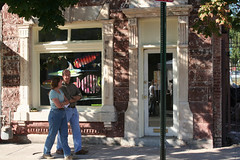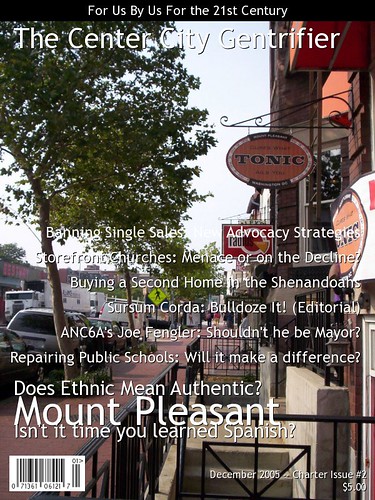Something from the archives
 This photo taken by Elise Bernard on H Street during the H Street festival last October, caused some controversy on her blog because the way the photo is shot, along with the reality of H Street today, implied to at least one person that a sanitized, white H Street NE is desired. This led me to create a few fake magazine covers as a comment on the controversy.
This photo taken by Elise Bernard on H Street during the H Street festival last October, caused some controversy on her blog because the way the photo is shot, along with the reality of H Street today, implied to at least one person that a sanitized, white H Street NE is desired. This led me to create a few fake magazine covers as a comment on the controversy. Below is something I wrote in October 2003, that was published in the "themail" e-newsletter from DC Watch (I have renumbered and reparagraphed it slightly):
The Mayor’s Campaign to Attract 100,000 New Residents
The whole point about a city, if you are truly committed to the pedestrian-based urban experience, is to not be automobile-dependent. I would never expect to be able to park in Fells Point or Little Italy (or Georgetown or Dupont Circle) on a Friday or Saturday night, unless I got there early. I would use other city-friendly forms of transportation. This leads to something that concerns me about the Mayor's campaign to attract 100,000 more residents to the City.
Obviously, attracting more residents to the city is something we need to do for many reasons -- to increase income tax revenues, to provide more residents -- eyes on the street -- to help stabilize various areas of the city, to provide more people clamoring for high-quality municipal services, etc. But I have some concerns.
First, there is no discussion of this as a “stretch goal” or an ideal. If I remember correctly, the market study performed for the H Street Strategic Development Plan forecasted a demand for about 15,000 units of new housing for the whole city over the next ten years. I worry that non-city friendly decisions that favor developers will be justified on the grounds that “the Mayor is trying to get more residents for the City” when planned housing production and availability of current units is likely to satisfy real demand without having to resort to special measures.
Second, if we attract 100,000 people that want to drive and park a car everywhere, rather than walking places and/or public transportation or other forms such as bicycling, then we will be destroying the quality of life of our city. In other words, if we attract 70,000 new households with 105,000 or so more vehicles clogging our streets (especially SUVs which take up about 1.5 parking spaces compared to regularly sized cars), owned by people who believe that it is their right and privilege to drive and park their vehicles in the public space — for free — we may well ruin the character of our city. Let's not suburbanize Washington, DC!
Enhancing public transportation in all ways should be the foundation of the “City Living” campaign — enhanced bus services (including maps and marketing), the reinsertion of trolleys in major transportation corridors, continued expansion of heavy rail and the creation of “infill” stations, requiring office buildings to develop transportation demand management programs (like Arlington County), support of Metrochek, etc. -- are a piece of the puzzle.
A “transit city” must keep growing its transportation infrastructure and expanding pro-transit policies and development. If we cede the city to the car, then we will give up all that makes the city livable.
In my opinion, there are seven other foundational pieces that are required as well:
(3) a true problem-oriented policing strategy that reduces crime in a substantive manner;
(4) substantive improvements in the quality of K-12 education (too many people feel forced to send their children to private schools) — charter schools are a start but only a start — as a city we should be committed to creating the best possible public school system that we can, and clearly it has almost nothing to do with money — the school system gets plenty; (Note: I no longer support charter schools to the same extent because the way the system has been gamed politically in support of such institutions.)
(5) fundamental improvements in the quality and cost-effectiveness of municipal services (insert your own experiences here);
(6) a commitment to providing a diversity of housing types and opportunities that provide real affordable housing options (the pace of change in the housing market in the core of the city is moving! so fast that within ten years a “Manhattan-Brooklyn Heights-Park Slope” upscaling is inevitable unless we address this now);
(7) a commitment to retaining and expanding the number of businesses located in the center city — that is the job and tax engine that supports the city generally, and provides the reason for people living in the city to begin with; and
(8) a commitment to enhancing the systems of job training-vocational education-apprentice programs to ensure greater employment of all DC residents — in a city of 60 percent African-American residents doesn't it astound you when you look at a construction project almost anywhere in the City and you see almost no African-Americans working on the site?, etc.
(9) Finally, any benefits provided to new home owners should be targeted:
(a.) people should be encouraged to live near and use transit with programs such as the location efficient mortgage; and
(b.) property purchase-related tax credits should be given only for houses in areas that really need incentives to attract new residents — it makes no sense for someone buying a $700,000 house in Capitol Hill to get a $5,000 tax credit, but how about offering a larger tax credit to buy in communities like Ivy City, Trinidad, Anacostia, etc.?
 A fake magazine cover I produced as a comment on the fact that neighborhood change is contentious.
A fake magazine cover I produced as a comment on the fact that neighborhood change is contentious.Index Keywords: urban-revitalization



0 Comments:
Post a Comment
<< Home